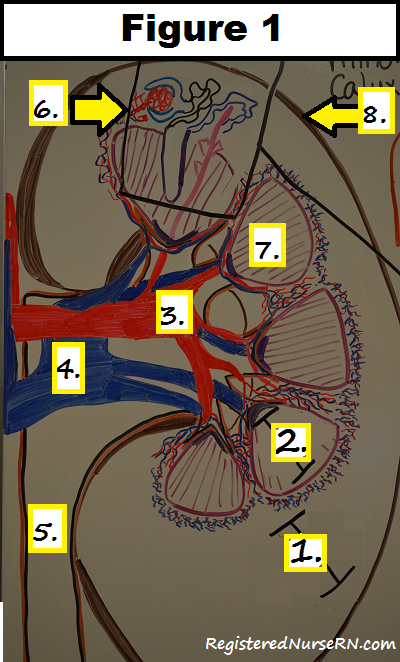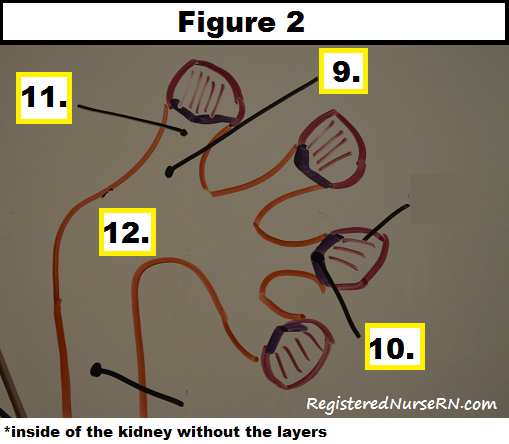This is a quiz on the anatomy of the kidney and nephron.
Before you start studying the renal system for NCLEX, it is very important you understand the basic anatomy and physiology of the kidney and nephron.
These structures are affected by disease processes of the renal system and can lead to various signs and symptoms.
This quiz and review will start our renal series. So, don’t forget to check out the other videos and reviews in this series.
NOTE: Use Figures 1-3 to assist you in answering the quiz questions:



Kidney and Nephron Anatomy Quiz
This quiz will test you on the structure of the kidney and nephron in preparation for the NCLEX exam.
Kidney and Nephron Anatomy Quiz
1. In Figure 1, what areas are labeled as Number 1 and 2?
A. Number 1: Renal Medulla; Number 2: Renal Cortex
B. Number 1: Renal Cortex; Number 2: Renal Medulla
C. Number 1: Renal Capsule; Number 2: Minor Calyx
D. Number 1: Minor Calyx; Number 2: Major Calyx
2. The functional part of the kidney is known as the ________ and is displayed as number 6 in Figure 1.
A. Renal Pyramid
B. Renal Pelvis
C. Nephron
D. Collecting ducts
3. Which statement below is true regarding the Loop of Henle?
A. The Loop of Henle is found in both the renal cortex and renal medulla.
B. The Loop of Henle is the largest part of the nephron.
C. The Loop of Henle is responsible for ultrafiltration.
D. The Loop of Henle is found in the renal medulla of the kidney.
4. In Figure 1, Number 7 represents?
A. Renal Cortex
B. Renal Pyramid
C. Renal Column
D. Major Calyx
5. True or False: In Figure 1, Number 3 represents the renal artery and Number 4 represents renal vein.
6. Which number represents the outer layer of the kidney that gives the kidney its shape and provides protection to the kidney from infection that may occur from surrounding organs?
A. Number 9
B. Number 12
C. Number 8
D. Number 13
7. Which option below represents the correct order in how filtrate flows through the nephron?
A. Bowman’s Capsule, glomerulus, proximal convoluted duct, loop of Henle, distal convoluted duct, collecting ducts
B. Glomerulus, Bowman’s Capsule, distal convoluted duct, proximal convoluted duct, loop of Henle, collecting ducts
C. Glomerulus, Bowman’s Capsule, proximal convoluted duct, loop of Henle, distal convoluted duct, collecting ducts
D. Glomerulus, Bowman’s Capsule, distal convoluted duct, loop of Henle, proximal convoluted duct, collecting ducts
8. In Figure 3, which numbers are considered the renal corpuscle of the kidney which plays a role in filtering the blood?
A. 15, 16
B. 13, 14
C. 16, 18
D. 15, 18
9. Which parts of the nephron play a role in tubule reabsorption and secretion? SELECT-ALL-THAT-APPLY:
A. Glomerulus
B. Afferent arteriole
C. Loop of Henle
D. Distal Convoluted Duct
E. Efferent arteriole
F. Proximal Convoluted Duct
G. Collecting Ducts
H. Vasa Recta
10. In Figure 2, you see the inside of the kidney where the urine that was created by the nephron is drained out of the kidney to the bladder. Select the option below that represents the correct order in how the urine flows out of the kidney once it leaves the nephron (collecting duct)?
A. Renal papilla, minor calyx, major calyx, renal pelvis, ureter, bladder, urethra
B. Minor calyx, major calyx, renal papilla, renal pelvis, ureter, bladder, urethra
C. Renal papilla, renal pelvis, minor calyx, major calyx, ureter, bladder, urethra
D. Renal papilla, major calyx, minor calyx, renal pelvis, ureter, bladder, urethra
11. The renal medulla’s environment is ___________ which plays a vital role (with the help of the nephron) in maintaining the water and salt balance in the body.
A. Isotonic
B. Hypotonic
C. Hypertonic
D. Hyper/hypotonic
12. __________ is the process where water and solutes are removed from the filtrate and enter back into the circulation via peritubular capillaries.
A. Tubular reabsorption
B. Renal secretion
C. Renal resorption
D. Tubular secretion
13. ________ is the process of where substances enter from the peritubular capillaries to the renal tubules (hence the filtrate).
A. Renal reabsorption
B. Tubular secretion
C. Tubular filtration
D. Tubular excretion
14. The structure that takes blood flow to the glomerulus for filtration is known as the ______________.
A. Efferent arteriole
B. Renal vein
C. Peritubular capillaries
D. Afferent arteriole
Answer Key:
- B
- C
- D
- B
- True
- C
- C
- B
- C, D, F, G
- A
- C
- A
- B
- D
More NCLEX Quizzes
Don’t forget to tell your friends about this quiz by sharing it your Facebook, Twitter, and other social media. You can also take more fun nursing quizzes.
*Disclaimer: While we do our best to provide students with accurate and in-depth study quizzes, this quiz/test is for educational and entertainment purposes only. Please refer to the latest NCLEX review books for the latest updates in nursing. This quiz is copyright RegisteredNurseRn.com. Please do not copy this quiz directly; however, please feel free to share a link to this page with students, friends, and others.
